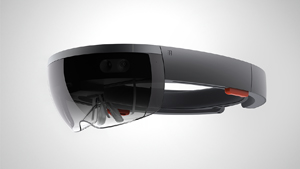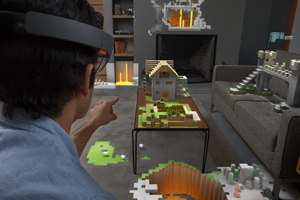We're in the very first stages of a leap in wearable tech that will rival the greatest breakthroughs in how we use computers.
Yes, this specific new wearable technology will someday be seen as significant as the point-and-click mouse or the mobile device touchscreen.
It's called augmented reality. It's a type of holographic projection, but merged with the real world.
 And the company at the cutting edge of this revolutionary wearable tech isn't Google Inc. (Nasdaq: GOOG, GOOGL), Apple Inc. (Nasdaq: AAPL), or Sony Corp. (NYSE ADR: SNE).
And the company at the cutting edge of this revolutionary wearable tech isn't Google Inc. (Nasdaq: GOOG, GOOGL), Apple Inc. (Nasdaq: AAPL), or Sony Corp. (NYSE ADR: SNE).
It's Microsoft Corp. (Nasdaq: MSFT).
Last month Microsoft unveiled its "HoloLens," the first salvo in what will be a war to dominate computing's next big leap. For the first time in more than a decade, Microsoft is leading the way in a major new technology.
The HoloLens doesn't look like something capable of changing how people use computers. In fact, it most closely resembles a pair of ski goggles.
And yet it's an entirely self-contained computing device. Microsoft says the chips inside the HoloLens can process terabytes of data in real time. That's incredible. One terabyte of data is equal to about 200 full-length HD movies.
But it's what that computing horsepower can do that makes the HoloLens such a game-changing piece of wearable tech.
The augmented reality of the HoloLens takes it well beyond much-maligned Google Glass or even the immersive virtual reality of the Oculus Rift.
Google Glass simply puts a tiny screen in front of the wearer's eye. The screen can display data, and the camera can take pictures and video. Glass is little more than a smartphone on your face.
The Oculus Rift, which Facebook Inc. (Nasdaq: FB) bought last year for $2 billion, has a bit more to offer. But it doesn't link virtual reality with the physical world.
The HoloLens, on the other hand, makes virtual objects look as though they are part of your local environment. And that opens up a lot of tantalizing applications.
The most obvious is gaming. Imagine playing a video game where the characters aren't merely on your screen - they're right in the room with you.
"The first time that teens see a mixed-reality hole blasted in their own bedroom walls revealing invading aliens rushing in behind them, they'll be hooked," Forrester analyst James L. McQuivey told TrustedReviews.
And that's just a glimpse of what's possible...
Holographic Wearable Tech Is a New Platform
Microsoft has demonstrated several intriguing use cases for its HoloLens.
For example, it has partnered with NASA to create a HoloLens simulation of the surface of Mars. Fully developed, such technology would allow scientists on Earth to virtually walk on the surface of other worlds.
Microsoft has also integrated Skype into the HoloLens.
 One person can guide another through a task using holographic images. The "helper" can see what the person needing help sees. Using a device such as a tablet the helper can draw images in the virtual environment as they explain what to do.
One person can guide another through a task using holographic images. The "helper" can see what the person needing help sees. Using a device such as a tablet the helper can draw images in the virtual environment as they explain what to do.
The HoloLens makes designing much more intuitive. Instead of looking at a design on a flat screen, the HoloLens makes it possible to see - and manipulate - the project as a virtual 3D object.
The HoloLens is able to work its magic through a combination of technologies. Cameras and sensors gather info on the physical environment so the virtual images can appear to rest on the floor, a table, or a chair. And those virtual images are beamed toward the user's eyes at just the right angle to fool the human brain into thinking they're real.
The augmented reality of the HoloLens is nothing short a new way of computing. It already has three key areas covered: productivity, communication, and gaming. And its potential is limitless.
"When Ikea builds a holographic catalog so that you can drop furniture into your bedroom and see what it would look like, even walk around it, you know you have a game changer," said Forrester's McQuivey told the Harvard Business Review.
Microsoft is not the only tech company that realizes this, of course. But it will be the first to market. The HoloLens is expected to debut before the end of the year along with Windows 10. HoloLens technology in fact, is an integral part of Windows 10.
While Microsoft has not announced a price, it has said the HoloLens will be "affordable." Given its capabilities, look for this wearable tech to cost about $1,000.
But as a new market with vast potential, you can bet we'll see more entries in this field in the next few years.
A Wearable Technology Gold Rush
McQuivey said that Forrester had identified 7.2 million early adopter customers for a product like HoloLens. These are people who like new tech and have the income to afford it.
As more players enter the space and the technology gets cheaper, that market will expand. Holographic tech will be a huge opportunity for companies that build what people want. And as with the mobile revolution, companies without a strategy for augmented reality will suffer.
[epom key="ddec3ef33420ef7c9964a4695c349764" redirect="" sourceid="" imported="false"]
Only a startup called Magic Leap, Inc. is anywhere close to where Microsoft is with the HoloLens right now. But don't underestimate it. Last October Magic Leap raised $542 million in Series B funding in a round led by Google and chipmaker Qualcomm Inc. (Nasdaq: QCOM).
But it's unclear when Magic Leap will release a product.
Also unreleased is Facebook's Oculus, although it's version of virtual reality is already behind the HoloLens.
And then there's Apple. Apple filed a patent for a wearable tech device that uses "interactive holograms" back in October 2012, so we know it's on the company's radar.
Sooner or later, Apple will produce an augmented reality device.
But as of now Microsoft has a big lead over everyone. And that could prove a mighty catalyst for Microsoft stock down the road.
"Holographic interactions like what Microsoft is suggesting are where every other company from Oculus to Google were ultimately heading, but they haven't gotten there," said McQuivey.
Why Microsoft Stock Is Rebounding: For more than a decade Microsoft stock went nowhere. But in the year since CEO Satya Nadella took over, MSFT stock has risen more than 21%. And it is poised to go higher. Here are five reasons why Microsoft under Nadella has turned around...
Follow me on Twitter @DavidGZeiler.
Related Articles:
- Trusted Reviews: Holographic Technology: How It's Set to Take Over Your World
- Harvard Business Review: What HoloLens Has That Google Glass Didn't
About the Author
David Zeiler, Associate Editor for Money Morning at Money Map Press, has been a journalist for more than 35 years, including 18 spent at The Baltimore Sun. He has worked as a writer, editor, and page designer at different times in his career. He's interviewed a number of well-known personalities - ranging from punk rock icon Joey Ramone to Apple Inc. co-founder Steve Wozniak.
Over the course of his journalistic career, Dave has covered many diverse subjects. Since arriving at Money Morning in 2011, he has focused primarily on technology. He's an expert on both Apple and cryptocurrencies. He started writing about Apple for The Sun in the mid-1990s, and had an Apple blog on The Sun's web site from 2007-2009. Dave's been writing about Bitcoin since 2011 - long before most people had even heard of it. He even mined it for a short time.
Dave has a BA in English and Mass Communications from Loyola University Maryland.



